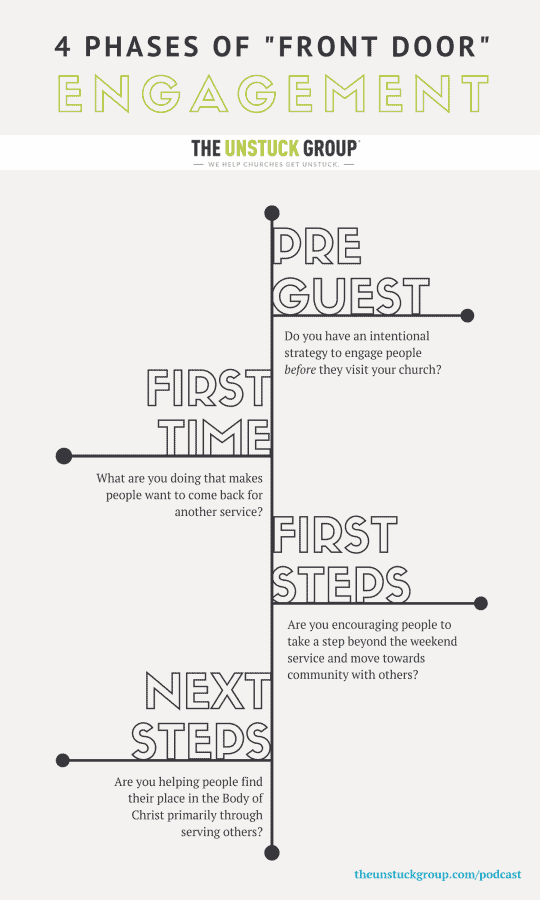Engaging Your Mission Field (Part 4)
If you enjoy this episode, subscribe on your device for more:
iTunes RSS Google Play Stitcher Spotify
Today we are closing out our four-part series that unpacks the key steps we see helping churches reach more new guests with the love of Jesus. Here are the four aspects we’re discussing:

All four are critical—but we’ve found most churches only have strategies and structure to engage one or two of them.
The fourth step is about helping people find their place in the Body of Christ. The win is all about engagement, helping people join the team and engage in their part of the church’s mission.
In this fourth episode of the series, Amy and I share:
- The stickiness factor that helps people shift from being a participant or a consumer to really being a contributor to the vision
- 4 strategies to help people engage in their part of the church’s mission
- Why we think you should consider flipping the steps in your discipleship path
Leader Conversation Guide
Want to take this conversation back to a staff or senior leadership team meeting?
Our Show Notes subscribers get a PDF download that recaps the episode content and includes a discussion guide you can print out and use at an upcoming meeting.
Opt-in here and get the Leader Conversation Guide for this episode, as well as access to the archive.
Share Your Thoughts and Questions on Social Media
We use #unstuckchurch on Twitter, and we start a real-time conversation each Wednesday morning when the episode drops. You can follow me @tonymorganlive and The Unstuck Group @unstuckgroup. If Facebook is where you spend your time, I’m there, too.
Links & Resources from the Episode
- 3 Reasons Why Your Church Isn’t Producing Spiritual Growth – Episode 102 | The Unstuck Church Podcast
- Pre-Guest Church Engagement – Episode 110 | The Unstuck Church Podcast
- First-Time Guest Engagement – Episode 111 | The Unstuck Church Podcast
- The Best Spiritual Gifts Test
Write a Review—It Helps!
Particularly on iTunes, your ratings and reviews really do help more pastors discover the podcast content I’m creating here. Would you take a minute to share your thoughts? Just open the the podcast on iTunes on your phone or computer, click Ratings & Reviews, and leave your opinion.
Transcript
Amy: 00:00 Welcome to everyone joining us today. We’re in the final week of a four part series on front door challenges in churches and we’re discussing the four phases of engaging new attenders. And for anyone jumping on board for the first time this week, Tony, can you just catch everyone up to speed?
Tony: 00:15 Yeah. In fact, Amy, I was just listening to the very first episode again in this series and apparently I have a little bit of passion about this. I don’t know why, but it’s been a fun series for me. In week one, we talked about strategies to help people before they even come to our churches. It was a discussion about having a pre guest strategy in our churches. Week two was about the first time guest experience and if you remember, the purpose of the second phase of this whole process is to get people to come back for a second visit and then hopefully a third and a fourth visit. And then last week we talked about the third phase, which is helping guests engage in the church beyond the weekend service. And we mentioned the win for that third phase is to help people begin to move towards community with other people.
Amy: 01:07 And that brings us to the final phase, which is all about next steps engagement.
Tony: 01:13 Yeah. So this fourth step is all about helping people find their place in the body of Christ. And so it’s not about showing up to worship more often. It’s not about becoming a church member. It’s not even about learning more about the Bible, this sounds a little bit like heresy, doesn’t it? But really the win here is all about engagement. The engagement process and helping people to join the team and engage in their part of the church’s mission.
Amy: 01:45 If that’s the win, I just have a couple of foundational questions first and then we can tackle more practical how to’s, as I listened to you, why isn’t the win more about connecting people to a group or to a class or a ministry program or something along those lines?
Tony: 02:01 Yeah. So the win here, we’re trying to increase the stickiness factor and we want people to really engage with our churches. And this may surprise you. Amy, I know you see this, I see it a lot, but we see people attending groups, attending classes, attending ministry programs at one church, but they’re not really engaged in that church. In fact, their engagement is in another church. It’s in the other church where they’re worshiping, they’re serving, they’re giving. So they participate at one church, but they’re not really engaged. And what we’ve seen is that participation is easier when you’re offering groups, classes, programs, but it doesn’t increase the stickiness factor in your church. And the stickiness factor really increases when people find their place in the body of Christ, when they are actually joining the mission of the church that God has given them for their life. And when that happens, they’ve started to shift from being a participant or a consumer to really being a contributor. They’re more invested, they’re bought in, they’re actually engaged.
Amy: 03:16 So when you say next steps, engagement is about helping people find their place in the body of Christ. What does that actually look like?
Tony: 03:23 So a couple things come to mind. First of all, this person now is on our discipleship path, the discipleship path that we’ve created to encourage people to increase the spiritual formation that’s happening in their life. And again, if you want more information or submit questions that you need to be considering to clarify your discipleship path in your church, I would encourage you to go back, listen to episode 102 where we talk about some primary reasons churches are not producing spiritual growth. So one aspect of this next step is the person is on the discipleship path. But the second step is that this person is serving inside and outside the walls of the church.
Amy: 04:12 So are you saying serving is more important than Bible teaching and study when it comes to engagement? Is that what I hear you saying,
Tony: 04:20 Amy? I kind of feel like this is one of those instances when the Pharisees are trying to trap Jesus. Ah, so you’re a, the question is…is serving more important than Bible teaching? Is that what you’re asking me?
Amy: 04:35 That’s what I want to know. Yes. I want to hear your answer.
Tony: 04:38 Yeah. And the reason why you’re asking it is I told you to ask me that question. So, first this is not an either or because first I’m assuming people already are getting great Bible teaching through your worship services and if not, if that’s not happening, we have a completely different issue to deal with. And then secondly, I’m assuming you’re already encouraging people to engage the Bible on their own. And again, if that’s not happening in your church, we have a completely different issue to deal with. So we’re not talking about engagement instead of Bible teaching, we’re talking about engagement in addition to Bible teaching. But then secondly, the answer to the question that I asked you to ask me is yes, when it comes to engagement, I believe asking people to follow Jesus and join his mission is more important than inviting them to study the Bible more. And it’s a bit of a chicken and egg argument, but I do think people will crave God’s word when they decide to follow Jesus and they’re going to crave God’s word when they join his mission. And frankly, I think this is what Jesus modeled for us. I think he’s a pretty good model and he invited people to follow him and join his mission. And so I think if we’re trying to engage people in the body of Christ this is the first step that we need to focus on.
Amy: 06:05 One more foundational question and then we’ll move on. I think I heard you say that part of finding our place in the body of Christ is about both serving others inside and outside the walls of the church. Did I hear that right?
Tony: 06:17 Yeah. And frankly I was listening to one of our recent podcasts and I think I waffled on this a little bit. So this may just be something that God’s confirming in me. And part of it is just because of what he has actually confirmed in me. I’ve seen this in my personal life. I really do think being a part of the body of Christ, first of all is finding our unique gifts, the gifts that he’s put in us and living out the mission God has called us to as a church. And I can’t make a theological argument for why someone should serve both inside and outside of the walls of the church. I’m not a theologian. All I can offer is what I’ve experienced personally and what I’ve seen in my life serving inside of the walls, of the church, it brings consistency to my connection with the mission of the church.
Tony: 07:07 I know that my team is counting on me. I’m expected to show up at a certain time and place. And that consistency also helps me develop stronger relational connection. Through the years I’ve been most connected to the people I serve with. Finally, it’s just easier for me to see that I’m part of something bigger than myself. And so I think serving inside of the walls of the church for me has been very important. And I think it, it should be valued in our churches. We should be encouraging everybody in our churches to serve some place inside the walls of the church and be a part of that bigger mission. But at the same time, again, this is what God’s done in me. I’ve seen that serving the needs of people outside the walls of the church is also very important, and it actually ties back to that first phase of the engagement process that we talked about a few weeks ago.
Tony: 08:01 Amy, I think serving people outside the walls of the church has opened the door for me to invite people to take their next steps toward Christ, especially when I’m serving someone with whom I have an established relationship. And here’s a little secret. You don’t need to take a spiritual gifts assessment to determine where and how you should serve. Instead, what I have found is just look and listen for the opportunities to serve others and then respond. Don’t wait for the church to organize a ministry event or program. Just start serving people. Love them. What I’ve noticed is when people respond to those God promptings, they serve others using the spiritual gifts that God has put in them, whether or not they’ve taken a spiritual gifts assessment. So, in addition to that, let me just offer this side note here. For the men that are listening in, the men that are attending your churches.
Tony: 08:57 And again, this isn’t universal for all men. But I think this is pretty key when we talk about engaging people primarily around serving. There’s been some research, a guy by the name of Robin Dunbar did some research about how people relate with each other. And in fact, it’s called the Dunbar’s number, which is exactly 150 people because his research identified that about 150 people is the limit of the number of people we can have meaningful relationships with at any one time. Now there are different levels of relationship that he talks about, but 150 is our max. Which by the way, all kinds of rabbit trails here. I think is why some churches never grow behind beyond 150 people is because there’s one pastor trying to do all the ministry and have all the relationship rather than empowering other people.
Tony: 10:00 So that’s another topic for another day. But part of Dunbar’s research was to also confirm something that you’ve just probably known in your gut for some time. He studied what strengthens relationships and prevents friendships from decaying and for women talking keeps relationships from decaying, for men though, talking does not help. And it’s funny, every man listening now is right now saying, I told you so. But guess what helps males deepen their relationships? What would you guess Amy? Football? Dunbar found it was actually doing stuff together. And again, it’s not a surprise to me that when guys lock arms and tackle a project or engage in something significant together when they’re actually doing something, that’s when their relationships go to a different level as well.
Amy: 11:07 Let’s get practical then. What are some best practices when it comes to the next steps? Engagement strategy?
Tony: 11:12 Yeah, so again, this is a carry over from last week when we were talking about this engagement process. The first best practice, one leader and one team needs to own this. You need to unify every next step beyond the weekend service under one leader in one team. Otherwise what we’ve seen is teams that are responsible for different aspects of these steps will start competing with each other for people’s time and attention. So one leader in one team. Secondly, I want to encourage you to consider to flip the steps in your discipleship path. And what we commonly see at churches is once people attend a weekend service they are trying to encourage people to get into a group and then get into a serving opportunity. But we’re seeing some churches that are flipping the second and third step and you may want to consider this as well.
Tony: 12:11 Moving serving before groups. And part of that has to do with our research. We have found that people are more likely to move from serving others to participating in a group or Bible study than they are to move from a group or Bible study into serving. And I’m not quite sure why that is, but I think it comes back to the difference of what it is to be a participant and what it is to really find your place in the body of Christ. So one opportunity is more about being a consumer. The other is more about being a contributor. One opportunity is more about me. I’m trying to learn more. One is more about you, I’m trying to serve you, I’m trying to serve others. But it may be even deeper than that. I think that finding our place in the body of Christ addresses some of the big questions that we’re asking at some point in our lives. Like who am I and why am I here? And when we find that place in the body of Christ where we’re really serving out of our giftedness and our passion, that’s where we actually are finding the answers to those key questions. So those are the first two, having one leader with one team and then considering flipping those first steps in your discipleship path. A third is to create easy and intentional on-ramps for people to serve in other ways. We need to make it easy for them to connect at the church and online and we need to offer a handful of first serve opportunities in each of our core ministry areas rather than trying to list every serving opportunity as at our church. Another best practice is to dedicate at least two Sundays every year to moving people from the seats into serving. And I personally like doing this sometime in January and sometime in July.
Tony: 14:04 January is good because everybody’s thinking about a new start in their lives. July, just selfishly because that’s when your’e trying to ramp up teams for the next school year. New Ministries are starting in August and September and it’s just good to have a fresh vision for why people should move from just being a participant in the worship experience to actually contributing by being on a serving team. When you do this, teach on the why behind serving and then make the ask in the service. Ask everybody to take the step and then give people an opportunity to respond to that ask in the service itself. Another best practice is just to make sure that your discipleship path points people to serving others both inside and outside the walls of the church. You have to make the path clear. You need to communicate it often in different ways using visuals.
Tony: 15:01 If people are going to remember one thing, it doesn’t need to be your mission statement. It doesn’t need to be the vision of where your church is going in the future. It just needs to be those clear next steps. You want people to take on your spiritual formation path, so where do they start, what’s their next step, and then how do they take that next step? You need to make that path clear. And then finally you really do need to measure and monitor as a church every ministry area and every campus, the fact that people that are actually engaging this next step and then that will create accountability for engagement throughout your team and will also help you uncover some best practices that are happening in one ministry or at one campus that can be shared with others on the team. Amy, anything you would add as far as best practices for this step?
Amy: 15:54 I don’t think I’d add anything. I think I’ll just endorse something that you mentioned about flipping to serving first. I don’t think you can underestimate how great it is, what a win it is. When new people begin to make friendships with other people in a group you’re kind of locked into, these are the people you’ve been given when you’re serving. There’s a way to find some natural friendships and find some natural relationships. I know that was my husband and my experience when we started serving. We got exposed to a lot of different people and became known and got to know a few of those people a little bit deeper. Eventually we got into a group with some of those people. Right, so it was just a more natural, I guess a way to not assimilate but to become part of the church.
Tony: 16:38 Good. Thanks for giving us that reminder too, Amy.
Amy: 16:41 You’re welcome. Okay. Any final thoughts, Tony?
Tony: 16:45 Yeah, I’d like to end where we began this series of podcasts. You need to be thinking about engagement and all four of these phases and we talked about the first phase being about pre guest engagement. The second phase is about first time guest experiences. The third phase is about first steps of engagement. Just those very first steps that you’re asking people to take beyond the weekend services, and then this fourth phase that we talked about today, it’s all about next steps, engagement and helping people find their place in the body of Christ. If you’re unclear about the importance of any of those phases, please go back and listen to those episodes. Your church needs a strategy around each of these phases of engagement, not just one or two of them. If you don’t have a strategy around each of these four steps, your attendance is likely to decline and people will not stick. And the reality is that you’ll have both a front door and a back door challenge. We need to connect people and we need to help them engage. And in case you missed it, the key theme throughout all four of these phases, it’s all linked to relationships.






